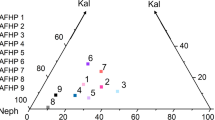Abstract
Mantle xenoliths hosted by the historic Volcan de San Antonio, La Palma, Canary Islands include veined spinel harzburgites and spinel dunites. Glasses and associated minerals in the vein system of veined xenoliths show a gradual transition in composition from broad veins to narrow veinlets. Broad veins contain alkali basaltic glass with semi-linear trace element patterns enriched in strongly incompatible elements. As the veins become narrower, the SiO2-contents in glass increase (46 → 67 wt% SiO2 in harzburgite, 43 → 58 wt% in dunite) and the trace element patterns change gradually to concave patterns depleted in moderately incompatible elements (e.g. HREE, Zr, Ti) relative to highly incompatible ones. The highest SiO2-contents (ca. 68% SiO2, low Ti-Fe-Mg-Ca-contents) and most extreme concave trace element patterns are exhibited by glass in unveined peridotite xenoliths. Clinopyroxenes shift from LREE-enriched augites in basaltic glass, to REE-depleted Cr-diopside in highly silicic glass. Estimates indicate that the most silicic glasses represent melts in, or near, equilibrium with their host peridotites. The observed trace element changes are compatible with formation of the silicic melts by processes involving infiltration of basaltic melts into mantle peridotite followed by reactions and crystallization. The Fe-Mg interdiffusion profiles in olivine porphyroclasts adjacent to the veins indicate a minimum period of diffusion of 600 years, implying that the reaction processes have taken place in situ in the upper mantle. The CaO-TiO2-La/Nd relationships of mantle rocks may be used to discriminate between metasomatism caused by carbonatitic and silicic melts. Unveined mantle xenoliths from La Palma and Hierro (Canary Islands) show a wide range in La/Nd ratios with relatively constant, low-CaO contents which is compatible with metasomatism of “normal” abyssal peridotite by silicic melts. Peridotite xenoliths from Tenerife show somewhat higher CaO and TiO2 contents than those from the other islands and may have been affected by basaltic or carbonatitic melts. The observed trace element signatures of ultramafic xenoliths from La Palma and other Canary Islands may be accounted for by addition of small amounts (1–7%) of highly silicic melt to unmetasomatized peridotite. Also ultramafic xenoliths from other localities, e.g. eastern Australia, show CaO-TiO2-La/Nd relationships compatible with metasomatism by silicic melts. These results suggest that silicic melts may represent important metasomatic agents.
Similar content being viewed by others
Author information
Authors and Affiliations
Additional information
Received: 15 November 1998 / Accepted: 17 May 1999
About this article
Cite this article
Wulff-Pedersen, E., Neumann, ER., Vannucci, R. et al. Silicic melts produced by reaction between peridotite and infiltrating basaltic melts: ion probe data on glasses and minerals in veined xenoliths from La Palma, Canary Islands. Contrib Mineral Petrol 137, 59–82 (1999). https://doi.org/10.1007/s004100050582
Issue Date:
DOI: https://doi.org/10.1007/s004100050582




